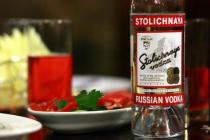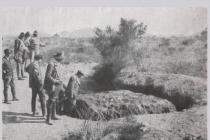One of the most charming places in Kyiv is the Kitaevsky Monastery, which is lost on the southern outskirts between forests and villages absorbed by the city. It has its own caves, similar to the caves of the Kiev Pechersk Lavra - but there is no pandemonium and pharisaism. There is a cathedral in the Ukrainian Baroque style. There was an amazing story about Saint Dositheos, who in the world was called Daria. And here I had a small meeting with the Lord God.
Kitaevo is practically a suburb. The metro does not go here, but minibuses from the center run regularly - minibus No. 470, connecting Kitaevo and Lavra and passing by several metro stations, is especially interesting. The nearest highway is Nauki Avenue, but it is more convenient to go to a nook near school No. 122. The monastery is hidden behind a high-rise building, the shadow of which occupies half the frame.
The road to the monastery, a look back. The private sector is an old village with the amazing name Myshelovka, known since 1618 as Meshalovka and incorporated into Kyiv in 1923. The atmosphere is completely Moscow region - probably, the outskirts of the capitals are generally similar:
Former monastery cemetery. In the background is a hill with caves:
Here is the monastery itself. If you follow this road further, after a couple of kilometers you will come straight to Pirogovo.
I don’t know what kind of youth they are, but they are clearly not pilgrims.
The economic part of the monastery on the other side has been occupied since 1930 by the Ukrainian Scientific Research Institute of Horticulture, but some of the buildings are clearly residential. Maybe there are some dorms here? And the building on the left seems to be a former monastery hospital:
A couple of years ago, the Church of Seraphim of Sarov was built here, and such a dedication - oh, not by chance!
Where Kitaevo comes from in Kyiv is about the same mystery as where Kitay-Gorod comes from in Moscow. Some say that China in Ancient Rus' was the name for silk or, on the contrary, one of the types of cheap fabric, others say that China is a pagan Slavic name, others trace it to the farmsteads of the Khitan nomads (whose state existed almost simultaneously with Kievan Rus - in 907-1125 years), thanks to which the Han Empire became known to the West as China... Be that as it may, the name is very ancient, but only in 1718 the monastery of the Kiev Pechersk Lavra arose here. More precisely, the “desert” is the place where the Lavra “elders” settled (well, it’s like that monk from “The Brothers Karamazov”). And since people were always drawn to the elders, and the Lavra was known throughout the Orthodox world, the monastery grew and was rebuilt in the 18th century.
And its ensemble has hardly changed - except for the 45-meter bell tower from the 1830s, dismantled under the Soviets:
Winter Church of the Twelve Apostles (1830s) - the monastery contains particles of the relics of all of them, except for John the Theologian, who, as we know, passed away without leaving a body on the Earth. Also here lies Theophilus of Kiev, one of the elders, the local Diogenes.
Residential building (1898). How beautiful it is in November if the Sun...
Trinity Cathedral (1763-67) is one of the last examples of “Ukrainian baroque”, the creation of Stepan Kovnir, another building of which I have already shown. And while walking around the cathedral, I’ll tell you the story that actually glorified Kitaevo throughout the country at that time - about Saint Dositheus.
In 1721, in the house of the Ryazan nobles Tyapkins, a daughter, Daria, was born, whom caring parents almost immediately gave to her grandmother - oh, how familiar! The grandmother was not simple - in her old age she became a nun, and not just anywhere, but in the Ascension Monastery of the Moscow Kremlin (later demolished under the Soviets). At the age of 9, the girl was taken back home, but they quickly noticed that she was something strange: she dresses in anything, sleeps not on the bed, but on a plank, eats bread and water, does not go to balls, oh, what will Princess Marya Aleksevna say... At the age of 16, they decided to marry Daria, and she simply ran away from Houses.
However, the time was different then, and now hitchhiking girls do not surprise anyone. For secrecy, Daria got hold of men's clothing, cut her hair and began to pretend to be the runaway peasant son Dosifei. At first, she asked to be a novice at the Trinity-Sergius Monastery (at that time it wasn’t even a monastery!), but soon her parents visited there, suspecting that they should look for the fugitive here - and without thinking twice Dosifey fled to Kyiv.
Inventing a legend for herself, Daria did not know Russian laws, according to which a runaway peasant could become a monk only with the permission of the Synod or the emperor, so Dosifei was doomed to remain a novice. The Kiev-Pechersk Lavra did not accept him, and then he settled in Kitaevo, with the blessing of the abbot, he dug himself a cell on a hill and began to pray there, eating bread and water and never, even in the coldest frost, heating his home with fire.
In general, the ascetic Dosifei soon became more famous and more revered than all the Kitaev elders. So much so that in 1744, while touring Little Russian possessions, Empress Elizaveta Petrovna visited him and gave him permission to become a monk. Although nothing fundamentally changed in Dosifei’s life - he was already an old man de facto. In 1776, the teenager Prokhor Moshnin, the future Seraphim of Sarov, came to them, whom Dosifei blessed to go to the Sarov hermitage. A few months later the old man died
According to legend, he bequeathed to bury his body without touching it, and Daria Tyapkina was identified by her sister from the portrait on the tombstone. To be honest, I don’t really believe this - after all, they haven’t seen each other for 40 years. I think that the secret was revealed in some more prosaic way, and very likely even before her death. And Dosithea of Kiev was canonized only in 1993.
I wandered around the monastery, enjoying the clear autumn air. Kyiv is still big, noisy and polluted, but here it’s quiet and peaceful. I talked to my aunt at the graves - at first I thought it was about politics, then I realized that it was just a quiet hysteria.
And then I saw this sign. Dosifei’s work continued after his death - his cell grew into caves similar to those in Lavra:
The monastery stands on a cascade of ponds, behind which the Goloseevsky Forest begins - this is the Kiev analogue of the Moscow Losiny Island, a national park within the city. In its depths there is another large monastery, Goloseevskaya Hermitage (revered, but all the buildings are new), various research institutes and hospitals... but this is a topic for a separate post, the material for which has not yet been collected. And people from those houses are walking on the pond:
A ladder leads to the caves:
The entrance to the caves is simple and inconspicuous. Nevertheless, people come here; in about half an hour a group forms, led by a young monk. There is no lighting in the caves, so everyone lights a candle. I came a little later, unsheathed my camera, and the boy from the photo above immediately said that it was forbidden to take photographs there! The monk clearly reluctantly supported him, and we began to descend.
Dark corridors, limestone walls, icons and candles, soot crosses “painted” by pilgrims on the ceiling... The caves are quite branched and confusing. Periodically, the monk and other visitors stopped in another cell, he told the story of another elder, and everyone prayed. I secretly and voluptuously indulged in the sin of forbidden photography. The longest prayer service was in the farthest cell of Dosithea. Then they left, and I thought - let me take a couple of frames with flash and catch up. Stripped off. I followed, and then my candle went out!
To be honest, I was scared, finding myself alone in the darkness of the dungeon. With my mind, of course, I understood that there was nothing to worry about and in a maximum of half an hour the monk would bring other people - but the fear of impenetrable darkness and oppressive arches is irrational. For a minute I rushed along the corridors, looking for some kind of passage, but the passages seemed to be closed. I tried to illuminate my way with camera flashes - but to no avail, but I still saved the footage from these flashes. Here is an example of an underground cell, in which an old man could live for years:
Finally, I pulled myself together and took my cell phone out of my pocket. Its screen shone a little weaker than a candle, and after a few minutes I got out. By that time, the monk was giving instructions to the next group - and then I jumped out from below and began to tell what happened. The monk nodded and simply said: “God will forgive!”, but it took me another 15 minutes to come to my senses. This was the last day, the previous one almost ended in disaster due to a poorly timed shot, and for some reason this episode really set my mind straight . It was God who blew out my candle and said: “Look at the world with your eyes, not your lens, you fool, otherwise you will get completely lost!”
Of course, now I understand that, in general, nothing special happened. But this episode was very important personally for me, becoming the answer to long-standing questions and doubts.
There is a place in Kyiv where you experience peace and tranquility. This is the Kitaevskaya Pustyn- one of the most beautiful places in the capital. Surprisingly, the bustle of the metropolis is not felt here at all, although Kitaevo is located within the city. There is a monastery and caves with monks' cells here. And around there are forests, lakes and silence.
Kitaevo is worth visiting for those who are interested in history, religion, and those who like to relax in nature and go fishing. This is a great place for walking with children.
Story Kitaevskaya Desert

This area is one of those where people settled in primitive times. During the times of Kievan Rus, monks came to these hills and founded hermitages here. Therefore, Kitaevo is often compared to Mount Athos in Greece.
On the territory of Kitaevo there are many shrines: miraculous icons, arks with the relics of saints, as well as burial places of monks. In addition, here you can visit the Holy Trinity Kitaevsky Monastery, the Church of the Holy 12 Apostles, the Church of Seraphim of Sarov and the cave temple of the Cathedral of the Blessed Virgin Mary.
Kitaevo is the resting place of holy ascetic monks. Lovers, newlyweds and simply people often come to one of these graves, namely the grave of the monk Dositheus, looking for help in arranging love affairs. However, as legend says, a woman is buried here who pretended to be a male monk.
People come to the relics of Theophilus of Kiev for healing. Church chronicles attribute the gift of miracles, predictions, and many feats to St. Theophilus. It is believed that he personally met with Emperor Nicholas I several times.
Kitaevo Caves

There is now an active cave church on the territory of Kitaevo. Before this, the Kitaevsky caves stood abandoned until 1857, when they were accidentally discovered. Now the caves are open to the public.
The Kitaev Caves are preserved and open enough to wander wherever you want, and civilized enough to feel safe. The narrow hundred-meter underground gallery branches out into many tiny chapels and cramped hermit cells.
The entrance to the caves is open on weekdays from 10:00 to 15:00, on weekends and church holidays - from 12:00 to 15:00. Visitors are greeted by the priest-monk. Entrance to the caves is free, but it is worth buying a candle. In the dungeon, it will be the only lighting and will create the right mood.
"Chinese" nature

The territory of Kitaevo includes three small ponds, which are called Kitaevskie. There are holy springs and baths here, so if you want to get water, take a container with you. When going for a walk, wear comfortable shoes. Kitaevo is located on the wooded Dnieper hills, and there are few concrete paths here.
The forest in Kitaevo is beautiful, although not dense, but tall. However, if you are going there for half a day, be sure to take food and water with you, since you will not be able to buy anything on the territory of the tract.
The oldest chestnut tree in Kyiv grows in Kitaevo. It bears the name of metropolitan Peter Mogila, who planted this tree more than 300 years ago. The height of the chestnut tree is more than 10 m, the trunk is 3.4 m.
Opening hours and how to get to Kitaevo?
Address: st. Kitaevskaya, 32.
Website: kitaevo.kiev.ua
Working hours: You can visit the Kitaevskaya Hermitage at any time. Divine services in the temple are held daily.
- From Art. metro station "Lybidskaya" by bus No. 20 to the stop "Kitaevskaya" or by bus No. 52 to the stop "Shkola".
- From Art. metro station "Vydubychi" by bus No. 43 or No. 65 to the stop "Korchevatoye-1" or "Prospekt Nauki".
- From Art. metro station "Friendship of Peoples" or "Pecherskaya", "Arsenalnaya" by bus No. 470 to the stop "Kitaevskaya".
Kitaevo is located on the eastern edge of the Goloseevsky forest and is one of the most interesting and at the same time little-known attractions of Kyiv. On this territory there are the Kitaevskaya hermitage with the grave of Saint Dosithea, a particle of the relics of Nicholas the Wonderworker and the ark with the relics of the 12 apostles of Christ, the parents of the Mother of God and the parents of John the Baptist, as well as an ancient settlement that was inhabited from the 8th to the 13th centuries AD. and was the southeastern outpost of Kyiv. This tract is decorated with a chain of picturesque ponds located in an almost wild forest, and all this is surrounded by modern Kiev. And to the east of the main courtyard of the Kitaevsky Monastery there is a cave complex, which we will see today.
02
. To get to the Kitaevskie Caves, you need to cross the Kitaevskie Ponds dam and climb the concrete stairs to the chapel, where the entrance to the caves is located. The first chapel here was built in 1909 by the housekeeper of the Kitaevskaya Hermitage, Archimandrite Theodosius. She died during the Soviet years; the current chapel was built in 2000. By the way, the date of construction of the modern chapel varies greatly from source to source. The year 2000 is indicated on the monastery's website, 2005 - in the pilgrim's guide purchased in the icon shop. There are other dates available online. Until 1995. But that's not the point. The caves are open to the public every day except Mondays, from 10:30 to 17:00. Candles can be purchased at the entrance. To take photographs inside, you need to get the blessing of the abbot of the monastery. 
03
. During the Khrushchev years, a tractor that was destroying a chapel above the caves fell into the ground. Due to the collapse, the part of the cave labyrinth closest to the entrance was damaged. Therefore, in the 1990s, during the restoration of the caves, their walls were reinforced with brickwork, and the first 16 meters were reinforced with reinforced concrete blocks. 
04
. These works were supervised by the Kyiv History Museum.
It probably couldn’t have been done differently, but certain sections of the caves have looked completely uncave-like ever since. 
05
. The staff of this museum, T.A. Bobrovsky and M.M. Strikharem, in 1991-1993, archaeological research was carried out on the surviving sections of the Kitaev caves. It has been established that the total length of the main gallery is about 100 meters. The height of its corridors, with circular (rounded) vaults, is 1.7-1.9 meters, width - 0.8-1.2 meters. The dimensions of the underground cells are from 2 to 5 meters in length, and about 2 meters in width. Today, the total length of cave corridors available for inspection is about 150 meters. 
06
. In the cells, along the walls, there are characteristic projections. For the most part, these are beds on which cave monks could sleep.
Also in the cells there are various shallow niches for icons, candles and lamps. 
07
. Kitaevsky caves, like other Kyiv dungeons, are dug in loess. This is a light yellow rock, clay-like sandstone.
Here and there in the caves, where there is no brickwork or whitewash (white paint), the original texture is visible. 
08.
The main gallery at its beginning has a church, consecrated in 2000 in honor of the Cathedral of the Blessed Virgin Mary. The background of this underground temple is as follows: schemamonk Titus began digging it at the end of the 9th century. But one day, when a fairly spacious room had already been excavated, in the midst of work, an unknown monk in a robe approached him and asked what he was doing. Having heard the answer, he said: “It’s a good idea, pleasing to God, and the church will really exist, but it won’t be built soon.” And so it happened. When Titus came for a blessing for the installation of the iconostasis, the then Metropolitan Arseny, having inquired about the opinion of the head of the hermitage and, having heard that he was ill, ordered to postpone the installation of the iconostasis until he recovered. The matter dragged on. However, Titus did not lose hope and remained to live on Kitai Mountain (at the entrance to the caves he had a cell built). As a result, the schemamonk died without seeing the realization of his idea of building a church in caves. And only in our time, in the early 1990s, when the first divine services, after many years of oblivion in the desert, were held in Kitaevo, the church was cleared and the altar was consecrated in the name of the Venerable Dosithea, who labored here in the 18th century. And on the days of celebrating the 2000th anniversary of the Nativity of Christ, the throne of the cave church of the 19th century, with the blessing of Metropolitan Vladimir, was renamed in honor of the Cathedral of the Most Holy Theotokos. The temple is closed to visitors to the caves - it is opened only for worship on the patronal feast day on January 8. 
09
. Researchers argue about the age of the Kitaevsky caves, which are very similar in structure to the caves of the Kiev Pechersk Lavra. At the beginning of the twentieth century A.D. Ertel, sharing the results of his research, argued about the extreme antiquity of the Kitaev caves. In particular, he mentioned ancient Russian graffiti discovered here, which has not survived to this day. Unfortunately, the diaries and plans drawn up by Ertel have been lost, but certain information is contained in his report to the Kyiv Society for the Protection of Antiquities and Art, as well as in newspaper articles published in those years. The period of residence of monks in the Kitaev caves, Ertel argued, covered a significant time from the 11th to the 17th centuries, that is, even after the Mongol-Tatar invasion, they were not deserted, but, on the contrary, served as a fairly reliable refuge for the Lavra monks. 
10
. Modern archaeological finds in the caves date back to the 17th century, that is, at the time when a new Lavra monastery was built at the foot of the mountain, in the area of the settlement. Wooden cells and a church appeared there. At the same time, most likely, the ancient caves were expanded and landscaped. As is known, in the 17th-18th centuries the configuration and general appearance of the famous Lavra caves changed, and similar work could have been carried out in the desert, administratively subordinate to the Lavra. During this and subsequent reconstructions, traces of the early stage of the history of the cave monastery disappeared. 
11
. In 1771, hermitage was prohibited by government decree in the Russian Empire. Monks were required to live only in monasteries.
This explains the almost century-long oblivion of the Kitaev caves, which resulted in numerous destructions for them. 
12
. And only in 1857, a novice of the Kitaevskaya Hermitage, Ivan Taranov, accidentally discovered a cave on the mountain: a stake he had driven into the ground had fallen into it.
The open dungeons were very reminiscent of the Lavra caves, and inside there were traces of the presence of monks. 
13
. After a superficial examination, the caves were filled up and forgotten for almost 60 years. Only in 1910-1912. Through the efforts of the Kyiv Society for the Protection of Antiquities and Art, the study of the dungeons began. The work was carried out by a team of sappers under the command of Colonel Pavlov and Captain Markevich. The expedition was headed by the above-mentioned A. Ertel. 
14
. A ventilation hole in the cave vault and crosses smoked with candles. The roots of the plants are visible.
There are about 4 meters of loess rock to the surface. 
15
. During 1989-1992, in addition to the main section of the Kitaev caves, as a result of archaeological exploration, separate small sections of underground galleries were discovered in the same hill: the first - about 7 meters long, at a distance of 15 meters north of the main entrance to the caves; the second is about 15 meters long, at a distance of 50 meters southwest of the main cave complex. According to researchers, these were branches of the same gallery, designated as the “main”, which, as a result of collapses, lost their direct connection with it. 
16
. The entire time I was in the caves, a woman I didn’t know was praying in one of the cells. Therefore, it was not possible to photograph this room. Meanwhile, according to some artifacts found here in 1994 by archaeologists, as well as the configuration of the cave, it was possible to assume that this was the place of the exploits of St. Dosithea. In this post I will not tell all the details, but this story is quite interesting and unusual. The fact is that out of the 26 years he lived in the monastery, he spent at least 10 years in a cave, and part of this time in seclusion. And only after the death of the elder it turned out that the ryassophore monk Dosifei was a woman (!) 
17
. The fact is that the family of the noble daughter Daria Tyapkina was against her desire to become a nun. Therefore, the girl ran away from home. Knowing that they would look for her in women's monasteries, Daria dressed like a young man and sought refuge in men's monasteries. Meanwhile, as the years passed, the fame of Dosifei’s gift of divination spread far beyond the monastery. Bourgeois and peasants, priests and nobles came to Dosifei for advice and guidance. Queen Elizabeth herself visited Kitaevo to receive spiritual advice from Dosifei. But after the death of the ascetic, it became clear WHO Dosifei was. It was this sin of the woman, who deceived the brethren and the abbot, that for a long time was an obstacle to her canonization. But in our days, sin was recognized as forced and Dosithea of Kiev was declared a saint in 1993. 
18
. I note that such a wonderful biography of St. Dosithea spread after the publication of a biography compiled in the 19th century by priest Vladimir Znosko. In fact, except for this author, no one else tried to trace in detail the biography of Daria Tyapkina. His story formed the basis of all the information about the Kitaev ascetic available today. However, it should be noted that the author of the notes on St. Dositheus did not provide any references to documents concerning the ascetic herself, and in his work, as a rule, used oral traditions. As a result, very interesting material was collected about Dosifei and some other Kyiv ascetics, but many of the facts cited by the author require clarification today. Well, we get out. 
19
. From the platform in front of the chapel with the entrance to the caves there is a good view of the monastery courtyard. 
20
. Before leaving, I climbed the forest paths to the very top of China Mountain. The first settlements in these places appeared in the III-II millennium BC. e. In the V-VI centuries. a settlement of Polyans arose, which laid the foundation for Kyiv. Soon Kyiv became the center of the Polyansky principality, which united the Slavic tribes into a single state of Kievan Rus. On this hill (40 meters above the level of the Dnieper), the glade-pagans built a settlement with a total area of 2.22 hectares. The location was so convenient that the settlement continued to exist in Christian times. HELL. Ertel assigned the role of the settlement in Kitaevo to the point that is named “Kuyava” in the chronicle, and is usually associated with Kiev. Kyiv, according to Ertel, arose later than Kitaevo. Unfortunately, I was walking here alone and I was not able to take a photo that would convey the scale of the centuries-old giant oak trees that are now growing on the site of the ancient settlement. 
21
. The staircase mentioned above that leads to the caves. The climb is quite steep (150 steps).
Halfway there is a rest bench. 
22
. Kitaevsky ponds. One of them even has a small fountain. As far as I understand, they were built by monks in the 19th century for fish farming (the monks fast for 200 days a year). In those days, the rich monastery economy (apiary, orchards, vineyards, fishing, vegetable gardens) made it possible not only to provide the inhabitants of the monastery with everything they needed and to supply food to the Kiev-Pechersk Lavra, but even to engage in trade. 
23
. I’ll tell you a little about the above-ground Trinity Church, which we saw from Kitai Mountain. On August 21, 1763, on the site of the dilapidated Sergius Church, the guardian of the Far Caves, Hieromonk Timofey, founded a new stone church. The construction was supervised by the famous Lavra “stone master” Stepan Kovnir. On May 28, 1767, it was consecrated in the name of the Holy Trinity. The cross-domed Trinity Church goes back in its constructive system to Byzantine models, and deviates from the common design only in that it has not one dome, but two (the second one above the altar). On August 6, 1853, the Kitaevskaya Hermitage became known as the Holy Trinity Hermitage. Then the main Trinity Church was thoroughly repaired and three more domes were added, turning it into a five-domed one. The graves of holy ascetics are located near the walls of the temple. 
24
. By the 20th century, the Kitaevskaya Hermitage even had its own water supply system, powered by a steam engine. But everything changed dramatically after the arrival of Soviet power. In the 1920s, the temples continued to operate, but the hermitage itself no longer belonged to the monks: a children’s colony was located in the cells, and some of the buildings were used by agricultural institutions. In 1930, the desert was finally liquidated, the territory and buildings were transferred to the All-Union Research Institute of Fruit and Berry Farming. The bell tower was dismantled in 1932, other buildings were badly damaged during the Second World War. After the war, the Republican Training and Production Plant for Beekeeping and the Ukrainian Research Institute of Plant Protection were located in the desert. The revival of the monastery began only in 1990. Since 1996 it has the status of an independent monastery. 
Still in Kyiv:
Kitaevo carries a specific sacred essence. Being there, there is a feeling of another dimension, parallel to reality. Time seems to stop moving. The peace and quiet of the monastery is not disturbed even by the nearby highway outside Kitay-Gorod; this place is separated from the bustle of the world. Only the nature around creates some sound in the form of the noise of leaves, birdsong, the movement of old branches on the trees.
Small mountains and hills for Chinese desert, form a kind of fence from the city. The mirrors of the five lakes reflect the domes of the old Holy Trinity Church surrounded by tall pine trees. Weeping willows grow around the water, in which the blue sky is visible.
Geographically, the territory of Kitaevo is this is a peninsula, which is located on the Dnieper hills, Goloseevsky district of Kyiv.
History of the Kitaevskaya desert
Before Christianity was adopted in Ukraine, this territory was the place of residence of the glades; later a fortress city grew here. In 1159 this land began to belong to the Kiev-Pechersk Monastery. The period from the 11th to the 17th centuries is characterized by the residence of many famous ascetics who were famous for their insight and prayerfulness. On the hill behind the dense greenery there is a wooden church hidden in it there are caves of the monks open to visitors. Kitaevo is not filled with tourists like other similar places, this makes it possible to forget the bustle of the city and feel the energy and strength of this place.
The name of the area presumably means " wall"(translation from the Turkic word "China"). Also, it can be designated as a fortification, siege tower, fortress. There is a legend that says that in the 12th century Andrei Bogolyubsky had a fortress-palace here called “China”.
China mountain
The fortress, which was once located on Kitay Mountain, was protected from the north-west by a ditch and rampart, and from other sides by water. The remains of the fortifications and fortresses of the 9th-11th centuries can still be seen in the local vicinity, although not much has been preserved; some places have become simply deserted. People lived in the settlement located here. It arose as a result of the fact that in the 11th century, during construction on the mountain, the shaft and ditch crumbled. The village was located even after the Mongol invasion in the 15th century.
The above-ground Lavra monastery and cave monastery on Kitay Mountain were founded in the fifteenth century by monks of the Kiev Pechersk Lavra. The monastery was destroyed in 1930, and then restored in the early 1990s.
Kitaevskie caves
At the top of China Mountain there is an entrance to the caves. Also, there is a small wooden chapel nearby, where a monk guide meets passers-by. Scientists suggest that these caves arose in pre-Christian times. They were designed for privacy and consisted of 4 levels. They protected themselves from enemies, stored provisions, and even maintained contact with other monasteries. Today, only part of the caves has survived, which is still quite large and interesting.
Unlike the Lavra Caves, the Kitaevskie Caves are not as popular, so there is no constant flow of people here. Here you can only meet groups of 3-5 people, or visiting families who simply walk through these ancient labyrinths. This place is not lit and there are no tours here. To move, you need a light source, which will be in the form of a candle or flashlight. The walls of the clay caves have various drawings and inscriptions; you can look at them while walking here. Also, it’s just interesting to sit in one of the cells on a clay couch.
Constant temperature and its own dry microclimate are preserved in the caves, regardless of the weather. There is a cave church here, which is closed to visitors. And everyone can visit the cells until 16.00.
Kitaevskaya Pustyn
Even many native Kiev residents do not know about the monastic monastery of Kitaev Pustyn, located on the outskirts of Kyiv. It is often called the second Athos. The uniqueness of the Chinese desert lies in the presence here of the relics of all 12 apostles (except for St. John the Theologian, whose body went with his soul to Paradise and Judas Iscarion, the traitor who fell away from the apostolic circle). Also, here you can find the relics of the righteous saints Joachim and Anna (parents of the Most Holy Theotokos) and righteous Zechariah and Elizabeth (parents of the Holy Forerunner and Baptist John) and many other great saints.
Kitaevo also contains a holy font. It has long been known for its healing properties and oxygenated water. The font can be found in the forest next to the Chinese Desert, five meters from the road. During excavations in 2004, the remains of an ancient water reservoir were discovered, which served to create the font. Restoration work showed that, thanks to the structure of oak beams, the underwater part was well preserved.
How to get there
Where to look: Kitaevskaya street, 15 (exact address of the Holy Trinity Church). Access by public transport: Art. Lybidskaya metro station, bus 52 to the Shkola stop, bus 20 to the Kitaevskaya Street stop, or from the Vydubichi metro station by buses 43, 65 to the Prospekt Nauki stop.
Kitaeva Pustyn (Ukraine) - description, history, location. Exact address and website. Tourist reviews, photos and videos.
- Tours for the New Year Worldwide
- Last minute tours Worldwide
Due to its external similarity, the Holy Trinity Monastery, located on the hills above the Dnieper among forests, is called the Ukrainian Athos. One of the hills is called Kitai Mountain; according to one version, this name gave the name to the monastery. The first settlers came to China Mountain from the Kiev Pechersk Lavra in the 16th and 17th centuries. The central temple of the monastery is the Holy Trinity Church.
According to legend, the monastery received its name from its founder, Prince Andrei Bogolyubsky, nicknamed “China”. Another interpretation of the name is associated with the ancient Russian fortified settlement located here - the southern outpost of Kyiv. The Turkic word “china” means fortification, fortress.
History of the monastery
It is generally accepted that the monastery near the ancient Kitaevsky caves arose in the 17th century. But the documented history of the monastery begins in 1716, when a wooden church in honor of St. Sergius of Radonezh, a refectory and cells were built here at the expense of Dmitry Golitsyn. A new refectory, also wooden, with a church in honor of the Three Russian Saints - Peter, Alexy and Jonah - was built with donations from Empress Elizabeth Petrovna.
The hermitage served as an agricultural “economy” and also served as a cemetery for the Lavra. In the second half of the 19th century, a separate economic farmstead was founded, where the old and new buildings of the almshouse were built.
Historically, the Kitaev Hermitage is the burial place of many thousands of ascetics of the Kiev Pechersk Lavra, and now whoever visits the monastery actually walks through the places of historical burials. Due to the sufficient distance from the city, the caves of Kitaevskaya Mountain have retained their ancient appearance almost unchanged.
Shrines of the monastery
Monastic services are held in the Holy Trinity and in the Church of the Holy 12 Apostles. In the same temple are the main shrines of the monastery: particles of the relics of the holy apostles and other saints, the relics of St. Theophilus, as well as the shrine of the monastery - a list of the miraculous icon of the Mother of God “Vatopedi”, its other name is “Slaughtered”. At the northern wall of the Holy Trinity Church are the relics of St. Dosithea.














